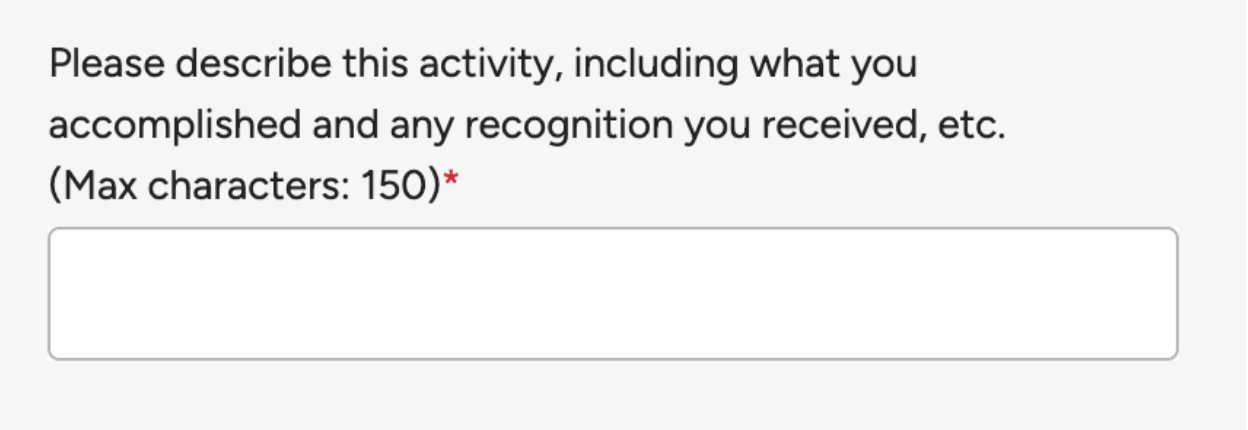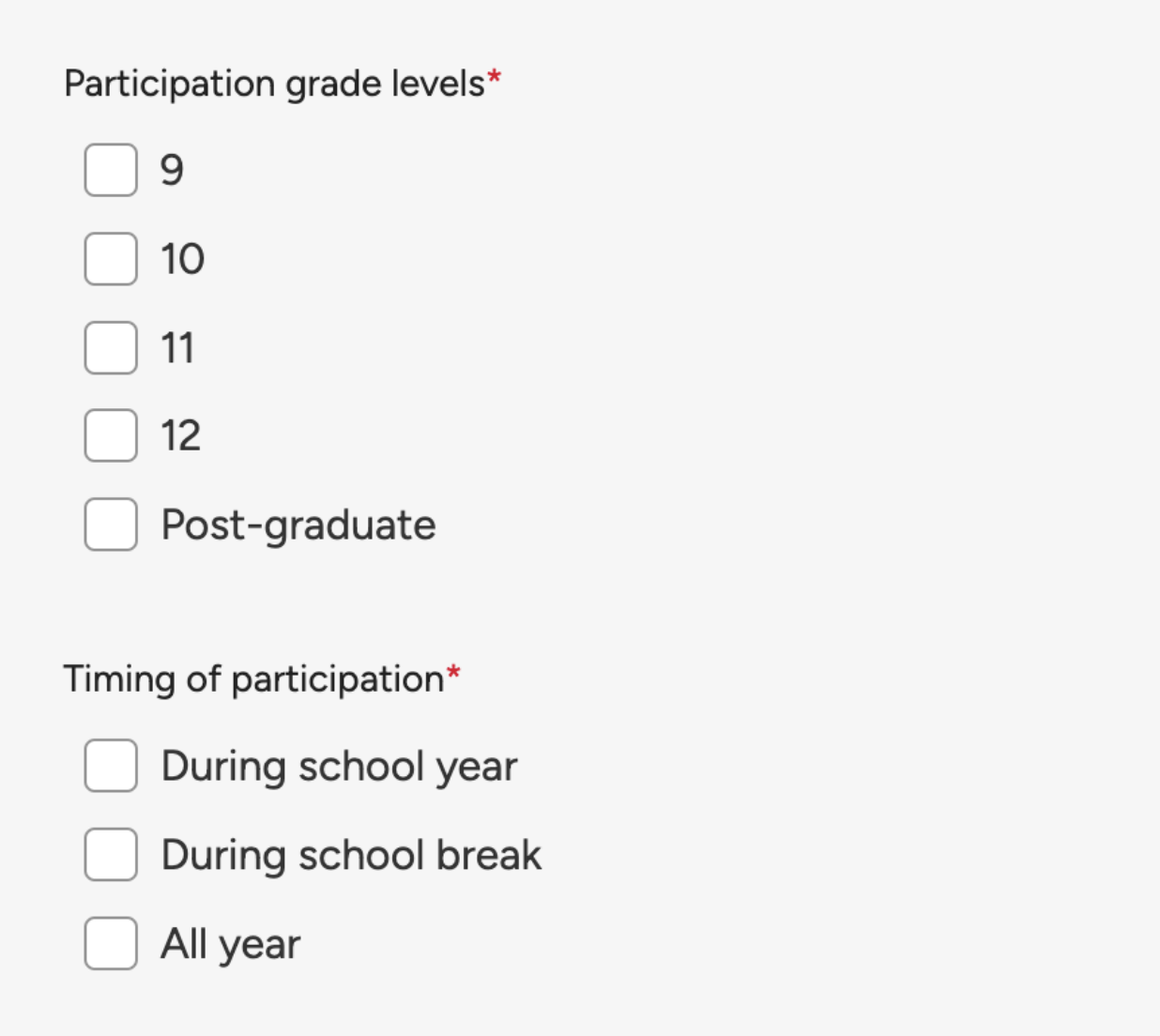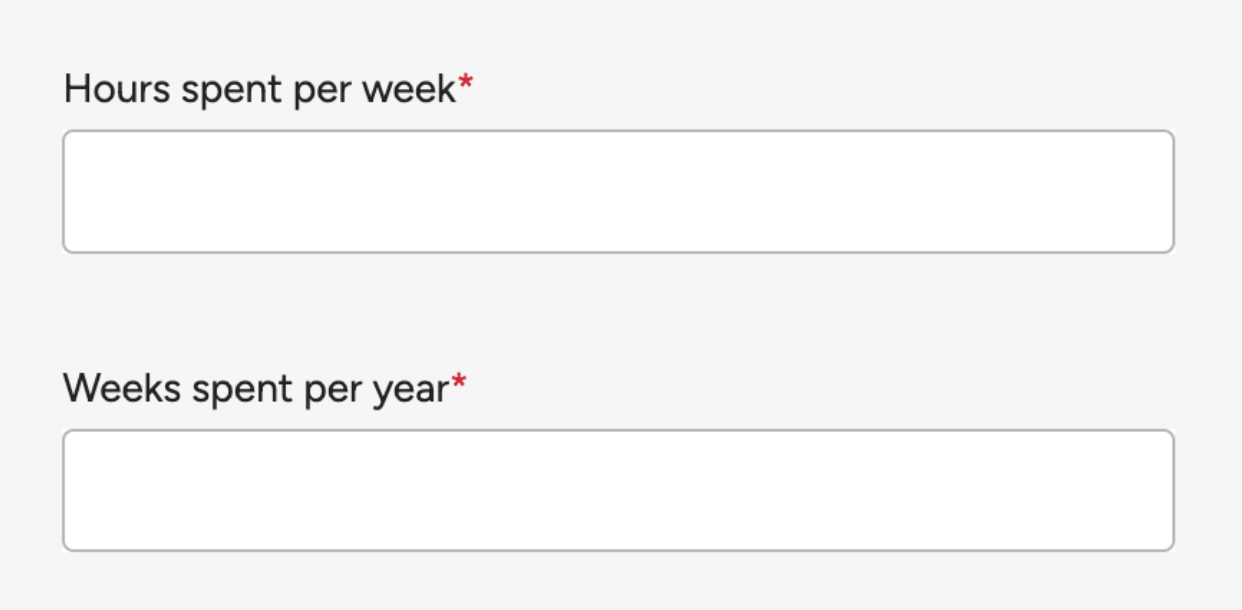Just Do It! Ideal Summer Programs for Discovery & Exploration
Read now/f/64062/800x450/4fac12dad2/environmental-science-banner-photo-blog.jpg)
/f/64062/1920x800/a7ea21d61c/extracurriculars-background.png)
The Activities List section of the Common App is where you provide information about your extracurricular and leadership (ECL) activities and achievements. More importantly, it’s your chance to show admissions officers who you are outside the classroom.
With only ten slots available and strict character limits, strategy is key. Your challenge is to condense all your experiences into a concise list that grabs attention. It's not just about describing how you spent your time. It’s also about making a strong impression.
In this blog post, I will break down the Activities List form by section. Then I will show you:
Let's get started!
The Activities List is where you list everything you’re involved with outside of the classroom. This includes sports, music and art, clubs, jobs or internships, personal commitments, and other pursuits.
For each activity, you fill out:


The options in the drop down menu for “Activity type” are:
Choose the category that most closely matches each activity. If the activity fits into two categories, choose the more relevant one. Don’t worry if it’s not a perfect match — you can expand on it in the description.
If your activity doesn’t seem to fit into any of the categories, choose “Other Club/Activity.” Then identify it in the “Position/Leadership” field.
Although top universities tend to prefer specialists over well-rounded students these days, they do still want to see some variety. If you’re choosing the same category for each activity, think of how you can frame some of your activities a little differently. For example, choosing “Environmental” instead of “Community Service (Volunteer)” for a trash pickup initiative, if your list is already heavy on community service.


In this field, you’ll name the position you held in the organization. Your answer is limited to 50 characters.
Be specific! Now is not the time to just write “member” and call it a day.


Here, write the name of the organization.
Assume that the admissions officer (AO) reading your application is NOT from your region, and describe organizations accordingly.


You’ve arrived at the most important part: the activity description. Now, you have to distill what you did into a painfully short 150 characters. Plus, you have to do it in a way that shows leadership, impact, and personal qualities. Needless to say, this requires strategy.
Let’s ignore the character limit for a moment. It’s time to wring every last drop of value from each of your activities. To do this, answer the following questions about each activity on your list.
Let’s do it together with a sample activity.
Activity Name: Community Service - Local Food Bank
| Question | Answer |
|---|---|
| What did you do? | Organized weekly volunteer schedules, coordinated food donations, and led a team of volunteers to distribute food to local families each week. |
| What problem(s) did you solve? | Ensured efficient distribution of food to families in need, managed volunteer resources effectively, addressed shortages in food supply by coordinating donations. |
| What skills did you develop? Include any awards or achievements. | Leadership: Directed and motivated a team of volunteers. Organizational: Managed schedules and coordinated logistics. Communication: Liaised with donors, volunteers, and families. Problem-solving: Addressed challenges in food supply and distribution. |
| What lessons did you learn? | The importance of community service and its direct impact on people's lives. Effective communication is crucial in organizing and leading teams. Flexibility and adaptability are key in addressing unexpected challenges. Collaboration and teamwork can significantly enhance the efficiency of operations. |
| What impact did you have? (Think NUMBERS.) | Successfully organized and led efforts to distribute food to over 200 families weekly. Coordinated a team of 10 volunteers, enhancing their efficiency and effectiveness. Increased the food bank’s operational efficiency by streamlining donation coordination — resulted in a 30% increase in donations from the previous year |
| How did you apply what you learned? | Used leadership and organizational skills in other extracurricular activities, such as student government or other clubs. Applied problem-solving techniques learned at the food bank to academic group projects, enhancing team performance. Shared insights and strategies on effective community service with peers, encouraging more students to volunteer and get involved in local community efforts. |
Do this for each of the activities on your list! Don’t forget to list any awards or achievements you earned for each activity.
Combine the above answers into a concise summary within the character limit. Keep these tips in mind:
With these tips in mind, let's write a description for our Food Bank example:
Volunteer Coordinator, Local Food Bank
Led and scheduled a team of 10 volunteers to distribute food to over 200 families each week. Streamlined website to increase food donations by 30%.


Select the year and duration for each activity. If you participated in an activity over the summer, choose the rising grade. For example, choose “11th grade” for activities you did over the summer between 10th and 11th grade.


In this section, you’ll estimate the amount of time you spent during each activity. If you don’t remember exactly how much time you’ve spent on a given activity, make a reasonable estimate. Your estimations should make sense and remain within the confines of spacetime!
Admissions officers know you’ll spend more time on some activities than on others. They simply want to know how you spend your time. Don’t worry about an equal distribution of time throughout all your activities.


Now, colleges want to know whether you plan to continue this type of activity in college. They ask this question because they are trying to fill the incoming class with a diverse range of students. They want to have an idea of what kind of student you’ll be on their campus.
Don’t overthink it! Just be honest. There is no way to anticipate how many saxophone players or entrepreneurs or environmental enthusiasts the college is looking for — or how many others are applying. Truly, your application is so much more than the “yes” or “no” answer to this question.
Ideally, you’ve been doing activities because you like them (not to get into a top university) so you’ll answer yes to at least some of them.
If you answer “yes” to this question, it doesn’t mean that you have to continue when you get to college. You are just indicating your interest here.
Wondering what types of activities “qualify” to be listed on your Activities List? Basically, anything you do outside of class is fair game. See this blog post for a list of extracurricular activities that look great on college applications.
Regardless of what type of activities you’re listing, be sure to include:
Based on data from thousands of Crimson students who have been accepted to top universities, as well as the combined experience of Former Admissions Officers on the Crimson staff, we’ve determined four main qualities that AOs are looking for in the Activities List: Leadership, impact, initiative, and ambition.
AOs scrutinize the Activities List on the Common App to gain a deeper understanding of your interests, commitments, and contributions outside the classroom. Here’s what they are looking for:
Admissions officers want to see evidence of your ability to lead and inspire others. Some examples of leadership positions are:
Admissions officers want to see the real difference you have made. That’s why it’s crucial to highlight the tangible outcomes of your involvement in activities. To do this, specify the numbers related to your activity — amount of money raised, number of people affected, etc.
AOs are interested in students who can identify opportunities, take action, and innovate. This could be starting a new club, launching a community service project, or initiating improvements within an existing organization. Demonstrating initiative shows your proactive nature and readiness to tackle challenges head-on.
AOs want to see that you have a clear vision for your future and are actively working towards making it a reality. They look for signs of ambition in your activities. Some ways to show this are: placing highly at respectable competitions, attaining a high level of mastery at something, and working towards long-term career goals.
They don’t have to be in chronological order! List the most impactful ones first. Typically, this means your leadership roles. If you've held leadership positions in any of your activities, strategically place them at the top of your list.
The only reason not to use all 10 spaces is if you do an activity that takes up all or most of your time — for example, you are an Olympic athlete.
Avoid using words that are redundant, and see how many words you can slash while still preserving the meaning. For example, here is a description that does NOT use space effectively:
Willowbrook City Council Funding Advisor, Willowbrook City Council
Worked as a funding advisor for Willowbrook City Council Creative Communities Funding Scheme to promote arts projects within the Willowbrook region.
It wastes so many characters saying “Willowbrook City Council” three separate times. Plus, the description simply restates the position title instead of showing impact or describing specifically what the student did.
Here is the same example rewritten to use space effectively:
Funding Advisor, Willowbrook City Council Creative Communities Funding Panel
Youngest ever appointed panel member; awarded $465,000 to 200+ arts groups; bi-yearly meetings to review Willowbrook cultural policy.
See how much more we got out of the same 150 characters?
Admissions officers pay attention to the time you spent on each activity. Be sure the numbers you list make sense! They are also looking for sustained commitment or growth over time. Include at least a few activities that demonstrate this.
Did you have to help with your younger siblings at home, or get a job to help support your family? Include it in your Activities List, along with any skills you picked up or impact you made.
Take a final look at your Activities List.
If not, you may need to reconsider your Activities List items!
The Activities List items below were revised to add specifics and show impact.
Founder & President, WHS Model UN Club
Chaired Model UN Club, coordinated meetings, led team at various conferences, and facilitated events.
What’s wrong with it?
Founder & President, WHS Model UN Club
Chaired first school Model UN Club; coordinated wkly mtgs for 30+ members; led team at 20+ reg’l & nat’l conferences; facilitated 3 reg’l events PY.
Class President/Student Council Representative, Silvercrest High School
I was both elected as the class president (the highest position at my school) as well as member on the student council.
What’s wrong with it?
President and Arts Captain, Silvercrest High School
Coordinated 6+ major school events; directed and produced school play; raised $20,000+ for new sports equipment; rep’d AHS at interschool conferences.
Cello Player, Cedar Springs Chamber Orchestra
Played cello in Cedar Springs Chamber Orchestra, performed concerts, mastered various music genres.
What’s wrong with it?
Cello Player, Cedar Springs Chamber Orchestra
Successfully auditioned, played 2 annual concerts in the fall and spring, mastered techniques in romantic, baroque, classical, and contemporary genres
1. Volunteer: City Department of Sustainability (only youth member)
16 hr/wk, 24 wk/yr. Developed cultural food distribution strategies for the city’s first Food Plan. Built 2 cultural gardens with 12 types of crop, 50+ Ibs food harvested
2. Capstone: Founder & President, SmartSustainableCities
12 hr/wk, 40 wk/yr. Nonprofit w/ 6 intl. chapters, 90+ members. Spoke at 3 UN conferences about smart transit equity; created 2 city plans promoting walkability.
3. Cultural: Youth intern, National Museum of Asian Art
8 hr/wk, 10 wk/yr. Learned x-ray based analysis and paper conservation techniques w/ archival records. Studied Japanese art curation methods.
4. Research: Student Researcher, George Mason University
30 hr/wk, 8 wk/yr. Researched relationship b/w freeway capping & gentrification through statistical modeling; paper under review at Transportation Research Board.
5. Student Govt: Elected Chair Ambassador (1 of 32), City Youth Council
6 hr/wk, 36 wk/yr. Rep’d 200k+ youth. Directed policy initiatives on homelessness; Curated national workshop for BIPOC-owned businesses: 70+ attendees
6. Volunteer: Intern, Asian American Resource Center
6 hr/wk, 24 wk/yr. Curated youth program on cultural education w/ 16 participants and 3k in funding. Led an intergenerational storytelling event w/ 80+ attendees
7. Debate: Co-Novice Coordinator, Speech & Debate Team
12 hr/wk, 36 wk/yr. Ranked top 5 LD debaters in state. Created/ taught 1:1 curriculum w/ 6 students; debated Asian American critical race arguments
8. Research: Student Researcher, UC Santa Cruz Summer Internship Program
20 hr/wk, 8 wk/yr. Developed code book from 11 interviews w/ members of Black nonprofits. Presented impact of land-based, Black resistance on contemporary racial justice
9. Research: Student Researcher, UT Austin
4 hr/wk, 26 wk/yr. Researched the impact of China’s Belt and Road Initiative on 8 Indigenous communities in the Pacific; published 3 Op-Eds on Indigeneity in geopolitics.
10. Other: Photographer
2 hr/wk, 40 wk/yr. Curated 5 photo-essays w/ 10+ pictures each; created online exhibit w/ 80+ views on involuntary displacement, urban sprawl, and parking in city
How Tesvara Got Into Stanford
1. Athletics: Synchronized Swimming, 3x Int’l Medalist, 7x Nat’l Medalist
20 hr/wk, 46 wk/yr. Premiere state team; elite top 3 nat’l team; US Jr Olympics 2022 - Gold x3, Silver; US Nationals 2022 - Bronze; 2023: Silver, Bronze; leadership award
2. Research: Prevalence of Anxiety/Depression in Artistic Swimmers 13-18
2 hr/wk, 36 wk/yr. Study author. Design/analyze survey of medicated depression 8.5% athletes vs 16% gen teens (p<.05); poster presentation; submitted NHSJS
3. Volunteer: Accredited SAT & Math Tutor, Free Online Int’l Peer Tutoring
1 hr/wk, 20 wk/yr. Facilitate critical thinking skills; mentor/enlighten 52 learners, 18 countries; assist in raising SAT scores on avg. by 50 pts
4. Social Justice: Founder & Fundraiser, Paws of Ukraine
1 hr/wk, 26 wk/yr. Aid war-displaced animals. Launch/manage non-profit; fundraise; crochet 100 collars/toys; 3 fairs, feature on UAnimals webpage; raised > $2000
5. Work: Private Artistic Swim Coach/Camp Counselor
1 hr/wk, 40 wk/yr. Coach 12 athletes' skill development up 2 levels; mentor 60 preteens to foster creativity/growth mindset; instill a passion for learning/exploration
6. Tech: Opi-O-Scope Prototype Developer, Stanford Clinical Neurosci Immersion
30 hr/wk, 2 wk/yr. Capstone project of AI injectable nanobot monitoring neurotransmitter levels to prevent opioid relapses; prototype development offer.
7. Career: Econ & Leadership Ambassador, Econ for Leaders 2023
30 hr/wk, 1 wk/yr. Selected to promote econ. education; enhance leadership/public speaking skills; network; integrate econ. analysis/decision-making; social media promotion
8. Academic: Author of Academic Papers on Mental Health
4 hr/wk, 12 wk/yr. Published: [redacted]. Criticize policies on access to rural health care; analyze US history of mental health stigma; explore correlation of social media & mental health
9. Foreign Language: Ukrainian; Ukrainian Catholic University & Duolingo
2 hr/wk, 46 wk/yr. Master Duolingo in 6 months; increasing proficiency with weekly online tutor, including discussions of history, culture, and politics of region
10. Athletics: Swim, Long Distance Free and Relay Athlete, Varsity Swim Team
4 hr/wk, 12 wk/yr. Region champs 2022; endurance specialist; contribute personal best 200(2:10:06) and 500(5:45:40) free; collaborate on relays; inflate morale
For more examples of REAL Activities Lists that were accepted to top universities including Stanford and the Ivy League, download this free eBook.
As you know by now, a successful Activities List is more than just a list of your extracurriculars. It's a vivid picture of who you are beyond the classroom. By following the strategies in this guide, you can be sure that your Activities List highlights your leadership, impact, initiative, and ambition — and leaves a lasting impression on admissions officers.
Writing a solid Activities List requires thoughtful reflection and strategic planning. If you’re not sure how to convey your activities in the best possible light,** **schedule a free consultation. Our Crimson experts have helped thousands of students get the most out of their Activities List and stand out from the crowd of other qualified applicants.
Crimson students are over 6.75x more likely to get into the Ivy League, Stanford, Duke, UChicago and other top 10 schools — and 98% of our students get into at least one of their target schools. Speak to an admissions counselor today** **to see how we can help you beat the odds!
Enter your SAT or ACT score to discover some schools for you!